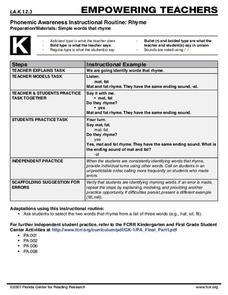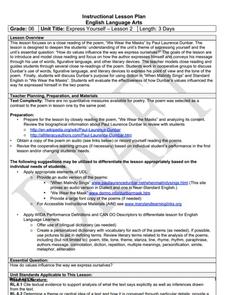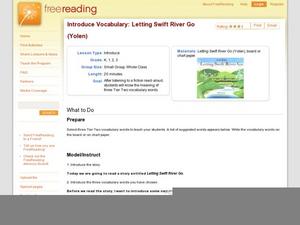Florida Center for Reading Research
Rhyme Flip Book
This rhyme book activity may look confusing at first, but it's really quite simple. Everything you'll need is right here and ready to use. Kids cut out and staple the pages of their own rhyme books. The only folds they will make are the...
Florida Center for Reading Research
Rhyming A-LOT-OH!
Rhymes are a great way to help your scholars with phonemic awareness and word relationships. Kids work with partners to match cards from a stack to their rhyming counterparts on a game board. There are six different boards, so this will...
Curated OER
Cross Patch
Leaners will recite "Cross Patch" and examine its related emotions and vocabulary. They chant "Cross Patch", participate in listening games and identify rhyming words. Afterward, they place the rhyme in their "My Very Own Nursery Rhyme...
Florida Center for Reading Research
Phonemic Awareness Instructional Routine: Rhyme
As a class, kindergarteners identify rhyming words. The teacher provides an example of a rhyming pair and explains why they rhyme. Individual learners then respond by saying a word that rhymes with a given word.
Curated OER
6th Grade: Express Yourself, Lesson 2: Close Read
The second lesson plan of a pair about Paul Laurence Dunbar, this plan focuses in particular on his poem, "We Wear the Masks." After a short historical introduction, class members conduct a series or readings, marking up the text and...
Curated OER
Figurative Language
Explore literary devices and figurative language using higher level examples. The 33 slides here define common types of figurative language (like simile, metaphor, personification, etc.), and then focus on specific examples in...
Curated OER
Gwendolyn the Library Fairy
Young scholars read a story. In this rhyming words lesson, students learn what rhyme is, read Gwendolyn the Library Fairy and identify rhyming words.
Curated OER
Introduce Vocabulary: Have You Seen Bugs? (Oppenheim)
Are your scholars interested in bugs? Get future entomologists excited about vocabulary through Joanne Oppenheim's colorful book Have You Seen Bugs? They use the informational text (although this strategy is useful for any book) to learn...
Curated OER
Genre Lesson: Poetry
Hook kids into a study on poetry elements by asking them to bring in the lyrics to their favorite song. Discuss the elements in one or two songs (preferably that demonstrate rhyme, figurative language, or a repeating phrase). Groups do...
Curated OER
Understanding the Poem
Practice literary analysis with your poetry pupils using the mysterious narrative poem "The Listeners." They examine the archaic language and answer 12 comprehension and analysis prompts. Foster creativity with these referential...
Curated OER
A Mysterious Story Poem
Your scholars will be hooked after reading the cryptic narrative poem "The Listeners." They explain why it is so mysterious, then use the poem to learn about pronouns. Learners read an excerpt from the poem that has been altered to not...
Curated OER
Sound Blending Lesson Plan
Mr. Snowman wants to help emerging readers understand compound words, so he segments some familiar words to help them see that they are made of two distinct words. Learners repeat the words, both segmented and blended, and observe them...
Curated OER
Introduce Vocabulary: Red Riding Hood (Marshall)
It's the classic story of Little Red Riding Hood retold by James Marshall; scholars listen for six new words as you read: bouquet, charming, escort, horrid, tarry, and wicked. Introduce the words before reading so they can listen for...
Curated OER
Introduce Vocabulary: Rap a Tap Tap (Dillon)
Explore the dancing prodigy and Depression-era African-American icon Bill Robinson as scholars learn new vocabulary words in context. As you read Leo Dillon's Rap a Tap Tap they listen for six new words: clatter, greet, passion, pause,...
Curated OER
Introduce Vocabulary: Letting Swift River Go (Yolen)
If your class is reading Jane Yolen's Letting Swift River Go, explore these vocabulary words in context: faint, quench, remain, and sacred. Before reading the story aloud, acquaint learners with these words briefly. As you read,...
Curated OER
Introduce Vocabulary: Miss Spider's Tea Party (Kirk)
Learning new vocabulary words is best done in the context of an engaging story like David Kirk's Miss Spider's Tea Party. New readers (or almost-readers) focus on any of 12 new words: conceal, courtesy, demand, descend, dread, fragile,...
Curated OER
Introduce Vocabulary: "I Can't," Said the Ant (Cameron)
With both rhyme and a fun storyline, Polly Cameron's story "I Can't," Said the Ant is a useful resource for vocabulary in context. Emerging readers focus on five key words: cooperate, mend, nimble, sling, and trickle. After a brief...
Curated OER
Introduce Vocabulary: How Do Dinosaurs Go To School? (Yolen)
Dinosaurs don't go to school...but what if they did? Use Jane Yolen's book How Do Dinosaurs Go To School to explore vocabulary in context. Find this on YouTube if you don't have the text on hand. These in-text words give some ideas of...
Curated OER
Introduce Vocabulary: Into the A, B, Sea (Rose)
As budding readers learn about the ocean, they'll get practice with the alphabet and new vocabulary words (cling, nab, prey, slumber, and thrive) in context. Read Deborah Rose's book Into the A, B, Sea, which includes a glossary in the...
Curated OER
Match the Rhymes
Which ones rhyme with swing? There are six images and scholars determine which ones rhyme. Two of the words are written out below to incorporate some printing practice as scholars trace the letters to form each single-syllable word....
Curated OER
Medial Sound u
Join Ug the Bug for some vowel sound practice focused on the short /u/ sound. Scholars examine six images and label each with a CVC word that has this as its medial phoneme. Next, they complete two rhyming sentences about Ug, using a...
Curated OER
Odd Ones Out
Some of these words don't rhyme; scholars determine which ones as they examine four sets of images with the vowel sound /e/. For each set, they circle the words that don't rhyme with the first image. Be sure kids know what these images...
Curated OER
The ee Sound
When two vowels take a walk, the first one does the talking! Scholars see this motto put to use as they study the /ee/ sound in various spelling patterns. Learners read a short introduction on this concept before reading several example...
Curated OER
The ai and ar Sounds
These words sound the same but are spelled differently, giving scholars a chance to practice spelling patterns and rhyming words. First they read that the /ai/ vowel sound can be made with three different spellings. Learners label three...

























